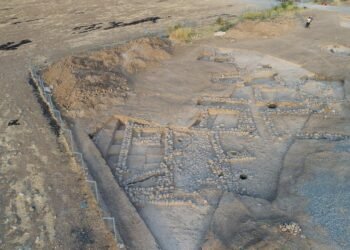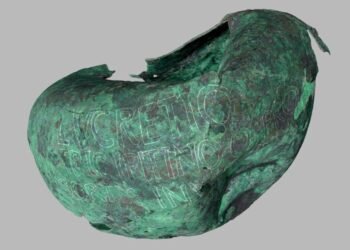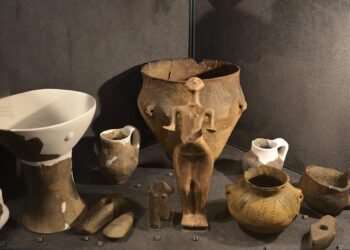Archaeologists unearthed an intact Roman enameled copper alloy chalice in a 6th-century Anglo-Saxon grave at Scremby, Lincolnshire. This rare artifact, dubbed the ‘Scremby Chalice,’ features the complex cultural and symbolic interactions between Roman and Anglo-Saxon societies.

The chalice was discovered during 2018 excavations led by the University of Sheffield as part of a study on the Migration Period cemetery at Scremby, which contained 49 burials dated between CE 480 and 540. Among them, the grave of a young woman, designated Sk18, stood out for its simplicity: only two circular brooches, a pair of bracelets, and the chalice were found. The placement of the chalice, intact and beside her head, indicated its special significance.
The chalice, measuring 57 mm in height with a capacity of 280 ml, dates to the 3rd century CE, likely originating from Roman Britain or possibly France, given stylistic and metallurgical parallels. Its elegant design features vertical panels filled with colored enamels in shades of blue, red, and aquamarine—a stark contrast to the horizontal decorations typical of Roman vessels. Researchers determined it was crafted using the lost-wax casting technique, showcasing Roman artisanship.
Unlike the fragmented Roman artifacts often found in Anglo-Saxon burials, the Scremby Chalice retained its original form and functionality, suggesting it may have been preserved as a family heirloom or recovered from an earlier Roman burial. The chalice’s intact condition and its placement within the grave indicate that it likely served a ceremonial or symbolic purpose.
The most intriguing finding came from the residue analysis of the chalice’s interior. Lipid residues revealed traces of porcine fats, unheated and raw, pointing to non-culinary uses. Researchers hypothesize that the fat may have served a medicinal or ritual purpose, echoing 6th-century Byzantine texts that reference pig fat as a treatment for infections.
The inclusion of the chalice in Sk18’s burial highlights its potential role as a marker of status or spiritual importance. As Roman materials were often imbued with mysticism in Anglo-Saxon contexts, the chalice may have symbolized power or continuity with the Roman past.
The Scremby Chalice stands out as a rare and invaluable find in the study of Roman and Anglo-Saxon archaeology. Its journey across centuries—from Roman workshops to an Anglo-Saxon grave—underscores the importance of examining artifacts not only as static objects but as vessels of cultural exchange and evolving meaning.






















Disclaimer: This website is a science-focused magazine that welcomes both academic and non-academic audiences. Comments are written by users and may include personal opinions or unverified claims. They do not necessarily reflect the views of our editorial team or rely on scientific evidence.
Comment Policy: We kindly ask all commenters to engage respectfully. Comments that contain offensive, insulting, degrading, discriminatory, or racist content will be automatically removed.
Love all the pictures and discoveries of the ancient world.l receive your bi monthly magazine which l enjoy reading, thank you, Barbara